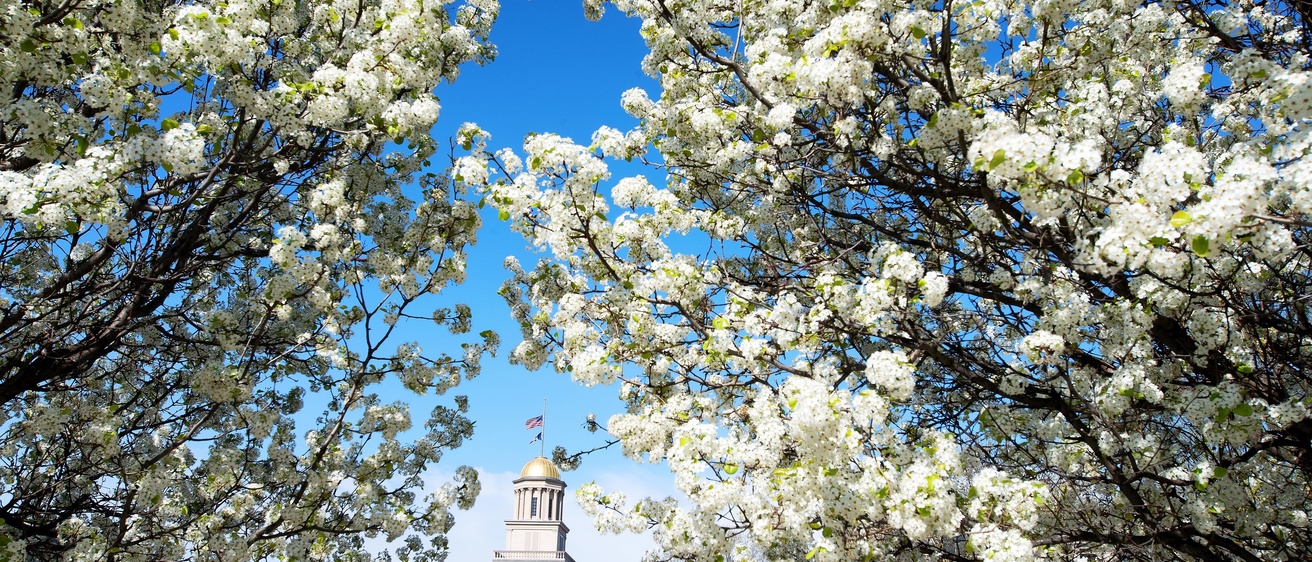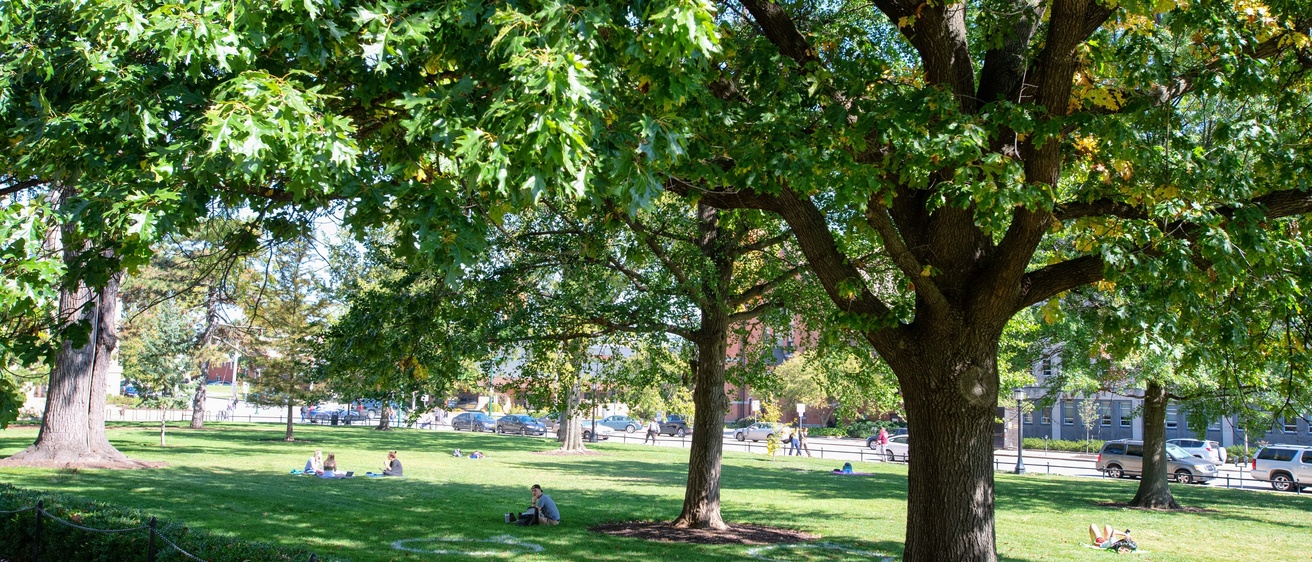About Us
Landscape Services maintains a campus with over 150 years of history and memories for faculty, staff, students and alumni. The campus, with trees hundreds of years old, spaces that have been home to generations of students, staff and faculty, areas where traditions were born and grounds that have seen history is under the care and guidance of the Landscape Services team.
Landscape Services Initiatives
UI Campus Arboretum Story Map
View a visual story map of the UI Campus Arboretum to learn more about our collection gardens, state-champion trees, literary groves, and more.
Landscape Services Responsibilities
For more on Landscape Services management processes, view the Landscape Services Management Plan.
Annual, Perennial, and Planting Bed Installation and Maintenance
Monitoring planting beds, annual beds, and perennial beds will include inspection of the plants for disease, insect, or other problems, deadheading of spent flowers and stems, removal of dead leaves, and pruning of broken branches. Pruning of planting beds will include the removal of broken, diseased or insect damaged branches. Watering of planting beds, annual beds, and perennial beds will include the regular application of water at a rate determined by the Grounds Supervisor according to weather, plant, and soil conditions.
- Preparation of annual beds will include the amending of soil, tilling, fertilizing or other work necessary to prepare the bed for annual flowers. Watering is accommodated to weather, soil and plant condition needs. Cleanup of annual beds will include the removal of annual plants from the previous growing season to make way for annual plants from the current growing season.
- Perennial beds receive an application of pre-emergent and slow release fertilizer in March, June, and September. Foliage growth of flowers are pruned after wilting of spring flowering bulbs. Cutting back perennials will include the removal of dead organic material at the end of the growing season. Perennials with winter interest can be left throughout the winter season at the direction of the Grounds Supervisor.
For a more detailed description of Landscape Service's annual and perennial flower bed maintenance and maps of flower and shrub bed locations, see the Landscape Services Management Plan.
Landscape Planning, Design, and Construction
Landscape Services is responsible for the planning, design and construction of the campus landscapes including site furniture, turf, trees, shrub and ground cover beds, and flower beds. With the University Design Standards as a guide, the Landscape Architect should have a reasoned purpose in formulating a plan for the campus landscape. The design should be flexible and effective in serving its intended purposes.
Litter and Waste Removal
Litter pick up will include the complete removal of all trash or other foreign objects from paved areas, lawns, steps and ramps. Litter pick up will also include the removal of visible trash from planting beds, annual beds, and perennial beds. Litter and debris is collected on basis of service level zones as determined by usage and traffic of campus facilities. The detailed litter and debris control plan includes procedures for litter, storm debris, cut grass, cigarette butts, and other types of foreign material. Landscape Services is also responsible for the installation and maintenance of trash and recycling receptacles.
Sidewalk Care and Maintenance
Sidewalks are maintained under the broader care of hardscape areas including plazas, retaining walls/outcropping stones, parking lots, and institutional roads. Walks, plazas, and steps are kept free from dirt and debris. Clean edges are maintained between turf and walks in Service Level A areas. Blowing or sweeping pavement will include the complete removal of dirt, sand, or other debris from pedestrian paved surfaces by using power blowers, brooms, or both.
Site Furniture Placement and Maintenance
Site amenities maintained installed and maintained by Landscape Services include bike racks, benches, tables, trash and recycling receptacles, fences, post and chain barriers, and building identification signs. Area Groundskeepers monitor and inspect the quality and condition of all site furniture and amenities in their assigned areas. Cleaning site furniture will include removal of postings, flyers, tape, stickers or other foreign objects from benches, tables, litter receptacles and other site amenities.
Snow and Ice Removal
The winter maintenance of all building entrances, steps, sidewalks, loading docks, Oakdale parking lots, service drives, and institutional roads under the control of the University of Iowa Facilities Management is the responsibility of Landscape Services. Our goal is to remove snow and ice from traveled surfaces in order to provide safe pedestrian and vehicular traffic. View snow removal maps here.
During normal working hours (7:00 a.m. to 4:30 p.m. Monday through Friday), snow and ice treatment will be initiated by the Landscape Services manager and supervisors or their representatives. It is our policy to respond to all snow and ice occurrences.
Outside of normal working hours, snow calls will be initiated by the UI Department of Public Safety as conditions require.
- Streets and service drives (and parking lots on the Oakdale Campus) will be plowed and treated with a sand/salt or ice-melt mixture.
- Sidewalks will be plowed and/or swept and treated with sand/salt or ice-melt mixture.
- Building entrances and steps will be shoveled and treated with a minimal amount of ice melt mixture. Sand is not to be used near building entrances.
Tree and Shrub Planting and Care
Landscape Services is responsible for approximately 6,500 trees on the main campus and 1,500 trees on the Oakdale campus. The selection of tree species and planting sites for campus tree installation by Landscape Services staff will be done collaboratively among the Landscape Architect, Landscape Designer, Grounds Supervisor, and Arborist. Watering of newly-installed trees will occur as needed for the first two years after planting. Tree pruning will vary depending on service level of campus spaces and follow ANSI A300 Standards including to provide pedestrian and vehicle clearing. Monitoring for insects and diseases shall be done based on the tree species that could be affected and the season of the year. Treatment decisions will be determined by the severity of the potential tree damage. Tree removal considerations shall be determined based on discussion among the Arborist, Grounds Supervisor, Landscape Designer, and Landscape Architect.
- The University of Iowa was first designated with the Tree Campus Higher Education award in 2009 for its dedication to the care of the campus' trees. The university has received this designation every year since for its continued service for campus trees.
- Landscape Services found a larva of the emerald ash borer in an ash tree in Gibson Square Park. Following the discovery, the Landscape Services tree crew developed a program to remove the infected trees and replace them with a variety of tree species. Read more on the Tree Removal and the Emerald Ash Borer page.
Shrub varieties are chosen to minimize the need to shear or prune shrubs. Maintenance practices are designed to promote the safe, healthy growth of plants. Pruning will occur to maintain size and shape, provide pedestrian clearance, and encourage flowering. Groundcover is managed to promote vigorous growth, minimize weeds, and control pests.
Learn more about the university's tree care practices on our Tree Management page.
Turf Development and Management
Landscape Services follows an organic-based, holistic and comprehensive approach, using the best management practices to promote and maintain a healthy turf. We continuously and proactively review practices and implement leading edge, ecofriendly methods and products while balancing the varied needs of the campus. Current practices include:
- 85% of the main UI campus is 100% organically maintained through healthy turf practices like mowing, aeration, de-thatching, etc. (approximately 200 of 244 acres)
- 13% of campus, in designated service levels, receive organic and organic-synthetic mix products as needed to control pests and weeds.
- Another 5% of campus, in low use, low maintenance areas, receives treatment with herbicides every 2-3 years to control weeds.
- The use of organic-based products helps build healthy turf and reduces usage rates of herbicides and nitrogen fertilizers by 50%.
- “Restricted Use” pesticides are NOT used on UI campus turf. None of the herbicides used on campus contain 2-4-D.
- Starting in 2018, most products applied are foliar, not granular, meaning they absorb into the plant directly through the plant tissue and not more slowly through the root system. This greatly reduces any chance of transfer or leaching.
In accordance with Iowa Agriculture and Land Stewardship policy, the UI is required to provide signage after any application of product, regardless of the coverage area or concentration/toxicity level. If one spot treatment is applied, the entire area is signed.
For more information on Facilities Management Turf Management philosophy, management practices, location and frequency, signage, and shared governance, check out our Turf Management Quick Facts document: Turf Management Quick Facts.
1,900
Acres
82
MILES OF SIDEWALKS AND BIKE PATHS
261
ACRES OF MAINTAINED TURF
8,000
TREES
35
MILES OF ROADS AND DRIVES
6,000
SHRUBS

